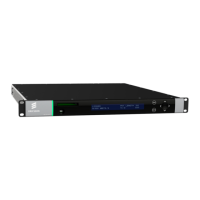Using the Equipment
Figure 3.169 How the Transport Stream is Routed through the Output Ports at the Various
Processing Stages
3.19.1 Searching the Minimum Bit Rate When Service Filtering
It is important to set the correct bit rate for the outgoing Transport Stream when
using any of the Service Filter modes. If the output bit rate is set too low this will
introduce PCR errors on the output Transport Stream. Lowering the bit rate
increases the mean Service Filter buffer level and this makes it more vulnerable to
buffer overflow if the incoming stream contains bursty traffic (packets not distributed
evenly) and peaks occur. When a buffer overflow occurs this can invalidate the PCR
re-stamping on the outgoing stream.
Service Splitting is a separate stage routed after Service Filtering stage and
therefore has the potential to be affected too. These stages are described in more
detail in the following sections.
3.19.1.1 TS Output Bit Rate Search
A button has been introduced to help determine the ideal or minimum bit rate to
configure the TS Output according to the services being filtered. This feature is only
available when the Service Filtering mode is active, i.e. Single Service, Multi Service
or Remap modes.
Note: The Search Minimum Bitrate function will affect the Service Filter modes
only. However, the resulting Transport Stream output from the Service Filter
stage will be routed to the Service Splitting stage and thus affect Service
Splitting. The bit rates defined in the Service Splitting configuration are not
modified or monitored.
A typical operational use case is described below:
1. Select the appropriate Service Filter Mode.
2. Configure the services for filtering under the Service Plus page.
CA
Descrambling
Service Filtering
and PID Remap
Service Spitting

